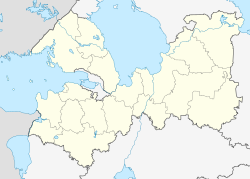Raivola
| Roshchino (in English) Рощино (Russian) |
|
|---|---|
| - Urban-type settlement - | |
 Location of Leningrad Oblast in Russia |
|
|
|
|
|
|
|
| Administrative status | |
| Country | Russia |
| Federal subject | Leningrad Oblast |
| Administrative district | Vyborgsky District |
| Municipal status (as of February 2010) | |
| Municipal district | Vyborgsky Municipal District |
| Urban settlement | Roshchinskoye Urban Settlement |
| Administrative center of | Roshchinskoye Urban Settlement |
| Statistics | |
| Population (2010 Census) | 13,439 inhabitants |
| Time zone | MSK (UTC+03:00) |
| Urban-type settlement status since | 1959 |
| Previous names | Raivola (until 1949) |
|
|
|
| on | |
Roshchino (Russian: Ро́щино; Finnish: Raivola), Raivola before 1948, is an urban locality (an urban-type settlement) in Vyborgsky District of Leningrad Oblast, Russia, and a station on the Saint Petersburg-Vyborg railroad. It is situated on the Karelian Isthmus 60 kilometers (37 mi) northwest of St. Petersburg, approximately halfway to Vyborg. Population: 13,439 (2010 Census);9,393 (2002 Census);8,436 (1989 Census).
In the wooded areas surrounding Roshchino there are multiple marshes and small lakes. Lintula larch forest is located some 3 kilometers (1.9 mi) to the west from the railroad station.
Raivola was first shown on maps of Finland in the 16th century. After 1812 it was under jurisdiction of Grand Duchy of Finland being part of Russian Empire, a part of the Viipuri Province. The mixed Russian-Finnish population of the area was engaged in agriculture. Around 1802 count Saltykov resettled some 609 of his subjects from Oryol Governorate to the area to meet growing manpower demands for his iron works; in addition to the iron foundry maps of mid-19th century show also sawmill. After the railroad to Helsinki was opened by czar Alexander II in 1870, Raivola was used for changing of locomotive crews. Establishment of the railroad station turned Raivola into suburb of St. Petersburg and development of the area continued with construction of summer cottages. By end of the century the population stood around 2,000, of which 169 were Finns. The village had shops, warehouses, two (Finnish and Russian) schools, and Russian Orthodox church of St. Nicholas with library and medical facility. Also hydro-electric power station and telephone station were established. The importance of the local railway station was eclipsed by Terijoki where Finnish customs depot was established in 1911
...
Wikipedia

